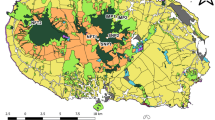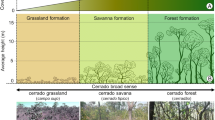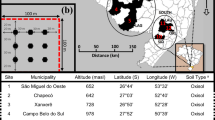Abstract
It is now understood that alterations in the species composition of soil organisms can lead to changes in aboveground communities. In this study, we assessed the importance of spatial scale and forest size on changes in arbuscular mycorrhizal fungal (AMF) spore communities by sampling AMF spores in soils of forested mainland and island sites in the vicinity of Gatun Lake, Republic of Panama. We encountered a total of 27 AMF species or morphospecies, with 17, 8, 1 and 1 from the genera Glomus, Acaulospora, Sclerosystis, and Scutellospora, respectively. At small scales (<100 m2), we found little evidence for spatial structuring of AMF communities (decay of Morisita-Horn community similarity with distance). However, at large spatial scales, we found that the AMF spore community of a mainland plot was more similar to other mainland plots several kilometers (>5) away than to nearby island plots (within 0.7 km). Likewise, most island plots were more similar to other island plots regardless of geographic separation. There was no decay in AMF species richness (number of species), or Shannon diversity (number of species and their spore numbers) either with decreasing forest-fragment size, or with decreasing plant species richness. Of the six most common species that composed almost 70% of the total spore volume, spores of Glomus “tsh” and G. clavisporum were more common in soils of mainland plots, while spores of Glomus “small brown” and Acaulospora mellea were more abundant in soils of island plots. None of these common AMF species showed significant associations with soil chemistry or plant diversity. We suggest that the convergence of common species found in AMF spore communities in soils of similar forest sizes was a result of forest fragmentation. Habitat-dependent convergence of AMF spore communities may result in differential survival of tree seedlings regenerating on islands versus mainland.




Similar content being viewed by others
References
Adler GH (2000) Tropical tree diversity, forest structure and the demography of a frugivorous rodent, the spiny rat (Proechimys semispinosus). J Zool 250:57–74
Allen EB, Rincon E, Allen MF, Perez-Jimenez A, Huante P (1998) Disturbance and seasonal dynamics of mycorrhizae in a tropical deciduous forest in Mexico. Biotropica 30:261–274
Anderson RC, Liberta AE, Dickman LA (1984) Interaction of vascular plants and vesicular-arbuscular mycorrhizal fungi across a soil moisture-nutrient gradient. Oecologia 64:111–117
Asquith NM, Wright SJ, Clauss MJ (1997) Does mammal community composition control recruitment in Neotropical forests? Evidence from Panama. Ecology 78:941–946
Augspurger CK (1984) Seedling survival of tropical tree species: interactions of dispersal distance, light-gaps, and pathogens. Ecology 65:1705–1712
Bever JD (1994) Feedback between plants and their soil communities in an old field community. Ecology 75:1965–1977
Bever JD (2002) Negative feedback within a mutualism: host-specific growth of mycorrhizal fungi reduces plant benefit. Proc R Soc London Biol Sci 269:2595–2601
Bever JD, Morton JB, Antonovics J, Schultz PA (1996) Host-dependent sporulation and species diversity of arbuscular mycorrhizal fungi in a mown grassland. J Ecol 84:71–82
Bever JD, Schultz PA, Pringle A, Morton JB (2001) Arbuscular mycorrhizal fungi: more diverse than meets the eye, and the ecological tale of why. BioScience 51:923–931
Castelli JP, Casper BB (2003) Intraspecific AM fungal variation contributes to plant-fungal feedback in a serpentine grassland. Ecology 84:323–336
Colwell RK (1997) EstimateS: Statistical estimation of species richness and shared species from samples. Version 6. User’s Guide and application published at: http://viceroy.eeb.uconn.edu/estimates
Daniels BA, Skipper HA (1982) Methods for the recovery and quantitative estimation of propagules from soil. In: Schenck NC (ed) Methods and principles of mycorrhizal research. American Phytopathological Society, St. Paul, pp 39–35
Eom AH, Hartnett DC, Wilson GWT (2000) Host plant species effects on arbuscular mycorrhizal fungal communities in tallgrass prairie. Oecologia 122:435–444
Eom AH, Kyllo D, Herre EA Nonrandom associations of arbuscular mycorrhizal fungi with different host trees in a tropical moist forest: implications for community composition. (submitted)
Fischer CR, Janos DP, Perry DA, Linderman RG, Sollins P (1994) Mycorrhiza inoculum potentials in tropical secondary succession. Biotropica 26:369–377
Gange AC, Brown VK, Sinclair GS (1993) Vesicular–arbuscular mycorrhizal fungi: a determinant of plant community structure in early succession. Funct Ecol 7:616–622
Garwood NC (1983) Seed germination in a season tropical forest in Panama: a community study. Ecol Monogr 53:159–181
Gerdemann JW, Trappe JM (1974) The Endogonaceae in the Pacific Northwest. Mycol Mem 5:1–76
Gilbert GS, Hubbell SP, Foster RB (1994) Density and distance-to-adult effects of a canker disease of trees in a moist tropical forest. Oecologia 98:100–108
Harms KE, Wright SJ, Calderón O, Hernández A, Herre AE (2000) Pervasive density–dependent recruitment enhances seedling diversity in a tropical forest. Nature 404:493–495
Hart MM, Reader RJ (2002) Taxonomic basis for variation in the colonization strategy of arbuscular mycorrhizal fungi. New Phytol 153:335–344
Hartnett DC, Wilson GWT (1999) Mycorrhizae influence plant community structure and diversity in tallgrass prairie. Ecology 80:1187–1195
Harinikumar KM, Bagyaraj DJ (1988) The effect of season on a VA mycorrhizae of Leucaena and Mango in a semi-arid tropic. Arid Soil Res Rehabil 2:139–143
Helgason T, Merryweather JW, Denison J, Wilson P, Young JPW, Fitter AH (2002) Selectivity and functional diversity in arbuscular mycorrhizas of co-occurring fungi and plants from a temperate deciduous woodland. J Ecol 90:371–384
Herrera, RA, Ulloa DR, Valdés-Lafont O, Priego AG, Valdés AR (1997) Ecotechnologies for the sustainable management of tropical forest diversity. Nat Resour 33:2–17
Husband R, Herre EA, Turner SL, Gallery R, Young JPW (2002) Molecular diversity of arbuscular mycorrhizal fungi and patterns of host association over time and space in a tropical forest. Mol Ecol 11:2669–2678
Janos DP (1980) Vesicular–arbuscular mycorrhizae affect lowland tropical rain forest plant growth. Ecology 61:151–162
Janos DP (1992) Heterogeneity and scale in tropical vesicular–arbuscular mycorrhiza formation. In: Read DJ, Lewis DH, Fitter AH, Alexander IJ (eds) Mycorrhizas in ecosystems. CAB International, Wallingford, pp 276–282
Janos DP, Sahley CT, Emmons LH (1995) Rodent dispersal of vesicular-arbuscular mycorrhizal fungi in Amazonian Peru. Ecology 76:1852–1858
Johnson NC (1993) Can fertilization of soil select less mutualistic mycorrhizae?. Ecol Appl 3:749–757
Johnson NC, Tilman D, Wedin D (1992) Plant and soil controls on mycorrhizal fungal communities. Ecology 73:2034–2042
Johnson NC, Wedin DA (1997) Soil carbon, nutrients, and mycorrhizae during conversion of dry tropical forest to grassland. Ecol Appl 7:171–182
Kiers ET, Lovelock CE, Krueger EL, Herre EA (2000) Differential effects of tropical arbuscular mycorrhizal fungal inocula on root colonization and tree seedling growth: implications for tropical forest diversity. Ecol Lett 3:106–113
Klironomos JN (2003) Variation in plant response to native and exotic arbuscular mycorrhizal fungi. Ecology 84:2292–2301
Lambers JHR, Clark JS, Beckage B (2002) Density-dependent mortality and the latitude gradient in species diversity. Nature 417:732–735
Leigh EG Jr, Wright SJ, Herre EA (1993) The decline of tree diversity on newly isolated tropical islands: a test of a null hypothesis and some implications. Evol Ecol 7:76–102
Leigh EG Jr (1999) Tropical forest ecology: a view from Barro Colorado Island. Oxford University Press, New York
Louis I, Lim G (1987) Spore density and root colonization of vesicular–arbuscular mycorrhizas in tropical soil. Trans Br Mycol Soc 88:207–212
Lovelock CE, Andersen K, Morton JB (2003) Arbuscular mycorrhizal communities in tropical forests are affected by host tree species and environment. Oecologia 135:268–279
MacArthur R, Wilson EO (1967) The theory of island biogeography. Princeton University Press, Princeton
Mangan SA, Adler GH (2002) Seasonal dispersal of arbuscular mycorrhizal fungi by spiny rats in a neotropical forest. Oecologia 131:587–597
Mills KM, Bever JD (1998) Maintenance of diversity within plant communities: soil pathogens as agents of feedback. Ecology 79:1595–1601
Mosse B (1972) Effects of different Endogone strains on the growth ofPaspalum notatum. Nature 239:221–223
Nemec S (1978) Response of six citrus rootstocks to three species of Glomus, a mycorrhizal fungus. Proc Fla State Hortic Soc 91:10–14
Olff H, Hoorens B, de Goede RGM, van der Putten WH, Gleichman JM (2000) Small-scale shifting mosaics of two dominant grassland species: the possible role of soil-borne pathogens. Oecologia 125:45–54
Packer A, Clay K (2000) Soil pathogens and spatial patterns of seedling mortality in a temperate tree. Nature 404:278–281
Picone C (2000) Diversity and abundance of arbuscular-mycorrhizal fungus spores in tropical forest and pasture. Biotropica 32:734–750
Pringle A, Bever JD (2002) Divergent phenologies may facilitate the coexistence of arbuscular mycorrhizal fungi in a North Carolina grassland. Am J Bot 89:1439–1446
Reynolds HL, Packer A, Bever JD, Clay K (2003) Grassroots ecology: plant-microbe-soil interactions as drivers of plant community structure and dynamics. Ecology 84:2281–2291
Sanders IR, Fitter AH (1992) Evidence for differential responses between host-fungus combinations of vesicular-arbuscular mycorrhizas from a grassland. Mycol Res 96:415–419
Sanders IR, Koide RT (1994) Nutrient acquisition and community structure in co-occurring mycotrophic and non-mycotrophic old-field annuals. Funct Ecol 8:77–84
SAS (1996) The SAS System for Windows, Version 6.11. SAS Institute, Cary
Schenck NC, Smith GS (1982) Responses of six species of vesicular-arbuscular mycorrhizal fungi and their effects on soybean at four soil temperatures. New Phytol 92:193–201
Siqueira JO, Carneiro MAC, Curi N, da Silva Rosado SC, Davide AC (1998) Mycorrhizal colonization and mycotrophic growth of native woody species as related to successional groups in Southeastern Brazil. For Ecol Manage 107:241–252
Streitwolf-Engel R, Boller T, Wiemken A, Sanders IR (1997) Clonal growth traits of two Prunella species are determined by cooccurring arbuscular mycorrhizal fungi from a calcareous grassland. J Ecol 85:181–191
van der Heijden MGA, Klironomos JN, Ursic M, Moutoglis P, Streitwolf-Engel R, Boller T, Wiemken A, Sanders IR (1998a) Mycorrhizal fungal diversity determines plant biodiversity, ecosystem variability and productivity. Nature 396:69–72
van der Heijden MGA, Boller T, Wiemken A, Sanders IR (1998b) Different arbuscular mycorrhizal fungal species are potential determinants of plant community structure. Ecology 79:2082–2091
Van der Putten WH, Vet LEM, Harvey JA, Wäckers FL (2001) Linking above- and belowground multitrophic interactions of plants, herbivores, pathogens, and their antagonists. Trends Ecol Evol 16:547–554
Wills C, Condit R, Foster RB, Hubbell SP (1997) Strong density- and diversity-related effects help to maintain tree species diversity in a neotropical forest. Proc Natl Acad Sci USA 94:1252–1257
Windsor DM (1990) Climate and moisture variability in a tropical forest: long-term records from Barro Colorado Island, Panama. Smithson Contrib Earth Sci 29:1–14
Yavitt JB (2000) Nutrient dynamics of soil derived from different parent material on Barro Colorado Island, Panama. Biotropica 32:198–207
Zangaro W, Nisizaki SMA, Domingos JCB, Nakano EM (2003) Mycorrhizal response and successional status in 80 woody species from south Brazil. J Trop Ecol 19:315–324
Acknowledgements
James D. Bever, Egbert G. Leigh Jr, Damond Kyllo, Sunshine Van Bael and two anonymous reviewers provided comments on earlier versions of this manuscript. We are indebted to Arturo Morris for identifying small plants within our study plots, and we thank the Smithsonian Tropical Research Institute (STRI) for providing research facilities. This study was supported by a STRI short-term fellowship to S.A.M. and a grant from the Andrew W. Mellon Foundation to E.A.H.
Author information
Authors and Affiliations
Corresponding author
Appendix
Appendix
Relative abundances are based on total spore volume (across all sites) for each species. Frequency of occurrence represents the number of the sampling points (maximum of 16 per site) in which spores of each AMF species were present in Table 7.
Rights and permissions
About this article
Cite this article
Mangan, S.A., Eom, AH., Adler, G.H. et al. Diversity of arbuscular mycorrhizal fungi across a fragmented forest in Panama: insular spore communities differ from mainland communities. Oecologia 141, 687–700 (2004). https://doi.org/10.1007/s00442-004-1684-2
Received:
Accepted:
Published:
Issue Date:
DOI: https://doi.org/10.1007/s00442-004-1684-2




